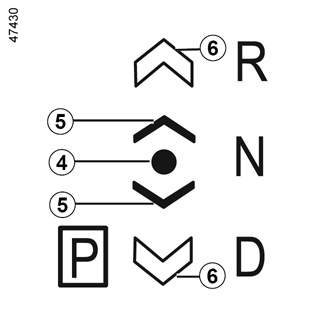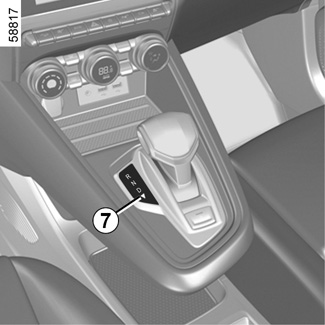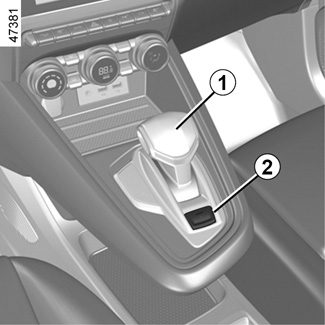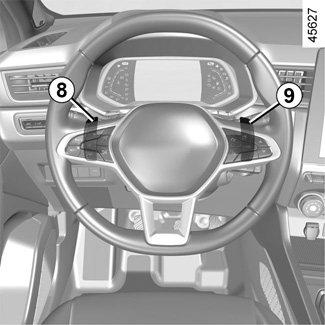AUTOMATIC GEARBOX, ELECTRONIC LEVER


Electronic selector lever 1
R: reverse
N: Neutral
D: automatic mode
P : park, button 2
The 3 indicator light displays the gear engaged.
On the instrument panel, the following symbols inform you:
4: position of the gear engaged;
5 : position accessible from the current position by moving the selector lever 1 one notch forwards or backwards;
6 : position accessible from the current position by moving the selector lever 1 two notches forwards or backwards.
The 5 or 6 symbols are displayed to indicate the gears that can be selected. If these symbols are absent this indicates that the gears cannot be selected from the current position.

The 7 triangle comes on when manual mode is activated.
Check that warning light P on the instrument panel and the warning light integrated on the button 2 are activated before leaving the vehicle.
Risk of loss of immobilisation of the vehicle.

One-touch selector
Move the selector lever 1 one or two notches forwards or backwards to engage the desired position (R, N or D) then release the lever and it will return to the stable position.
The selected position is displayed on the instrument panel along with the 4 warning light in front of the position.
If certain conditions prevent shifting from one position to another, the requested position flashes on the instrument panel.

To engage P position
With the vehicle at a standstill, engine running or ignition on, press button 2 to engage position P. The warning light on the 2 button lights up in orange once the Park position P on the gearbox is engaged.
To disengage position P
With the vehicle stationary and the engine running, press the brake pedal and, move the 1 selector lever forwards or backwards according to the position desired. The 2 button warning light switches off.
If the brake pedal is not fully depressed, the message “Press Brake Pedal” and the warning light are displayed on the instrument panel.
Note:
- if the driver opens their door to leave the vehicle and position P has not been engaged, a beep sounds and the message “P not engaged” is displayed on the instrument panel;
- the warning light appears each time the brake pedal must be pressed to change the automatic gearbox lever position.
To engage neutral
With the vehicle stopped and the engine running, to select N position, move the 1 selector lever one notch forwards or backwards according to the gear engaged.
Driving in automatic mode
With the vehicle stationary and the engine running, move the 1 selector lever two notches backwards to engage D position.
If one of the conditions is not applied, D flashes for around 5 seconds and the message “Push brake pedal” is displayed on the instrument panel for approximately 15 seconds.
In most road conditions you will encounter, you will not need to touch your lever again: the gears will change automatically at the right time and at the most suitable engine speed because the automatic system takes into account the vehicle load and road contour and adjusts itself to the particular driving style you have chosen.
Note: with the engine running and the vehicle travelling at between 0 and 5 mph (0 and 8 km/h), in position N or R, it is necessary to depress the brake pedal to engage position D. This is useful during parking manoeuvres requiring a number of alternate forward and reverse movements.
Economical driving
When driving, always leave the lever in position D, keeping the accelerator pedal lightly depressed to ensure automatic gear changes at a lower engine speed.
Accelerating and overtaking
Depress the accelerator pedal briskly and fully (so that it goes beyond the point of resistance).
It is also possible to shift down at any time for overtaking purposes, by pressing the left-hand paddle.
To select reverse gear
With the vehicle stationary and the engine running, move the 1 selector lever two notches forwards to engage position R.
If the brake pedal is not depressed, a beep will sound, the display of position R flashes for around 5 seconds in the grid shown on the instrument panel, and the message “Press Brake Pedal” is displayed for approximately 15 seconds.
Note: with the engine running and the vehicle moving between 0 and 5 mph (8 km/h), position N or D engaged, it is not necessary to depress the brake pedal to engage R. This is useful during parking manoeuvres requiring a number of alternate forward and reverse movements.


Gear shifting paddles 8 and 9
Depending on the vehicle, you can use paddles 8 and 9 to change gear when the lever is in position D.
8: Change to a lower gear.
9: Change to a higher gear.
P, N and R are not accessible using the paddles.
Driving in manual mode
When driving in position D you can switch to manual driving mode using paddles 8 and 9 on the steering wheel. Depending on the vehicle, two manual driving modes are available:
- the “temporary” manual mode can be used to force gear shifting by briefly pressing one of the two paddles. the driving mode D and the gear engaged appear on the instrument panel. the letter D and the lower arrow appear brighter on the indicator light 3.
Note: the gearbox adjusts itself to automatic mode D if the gear engaged is no longer optimal to vehicle performance or if no action has been taken on a paddle for a certain amount of time.
- permanent manual mode is activated by pressing and holding either of the paddles. Driving mode M and the gear engaged will appear on the 10 display on the instrument panel. All of the letters and the lower arrow appear as backlighting on the indicator light 3.
Note: depending on the vehicle, you can return to automatic mode by pressing and holding the right-hand paddle or by moving the one-touch lever 1 one or two notches backwards.
In all situations:
- to move down through the gears, press the left-hand paddle;
- to move up through the gears, press the right-hand paddle.
Note: depending on the display, the + and - or and indicators will suggest moving up or down a gear.
Special cases
In certain driving conditions (resulting in, for example, engine protection, operation of the Electronic Stability Control programme: ESC etc.) the automated system may change the gear automatically.
Likewise, to prevent incorrect manoeuvres, a gear change may be refused by the automatic system: in this case the gear display flashes for a few seconds as a warning.
Special circumstances
- If the road type or weather conditions (steep uphill slopes, sudden downhill slopes, deep snow, sand or mud) make it difficult to stay in automatic mode, depending on the vehicle, it is advisable to switch to manual mode using the paddles. This will prevent the automatic gearbox from changing gears repeatedly when climbing, and permit engine braking on long descents.
- In cold weather, to prevent the engine from stalling, wait a few seconds before moving the selector lever from position P or N and engaging it in D or R.
Parking the vehicle
On vehicles equipped with the lever 1, position P is automatically engaged as well as the electronic parking brake (on vehicles equipped) when:
- the engine is stopped;
- the driver’s seatbelt is unbuckled and the vehicle is stopped;
- the driver’s door is opened and the vehicle is stopped.
P is displayed on the instrument panel and the P button warning light is on.
As position P is automatically engaged when the engine is stopped, in some situations (e.g. when using some car washes) it may be necessary to engage position N:
- with the engine running, press the P button, move the selector lever 1 one notch forwards or backwards then stop the engine;
- with the engine off and the ignition on, move the selector lever 1 a notch forwards or backwards then switch-off the engine.
The next time the engine is restarted, position P is engaged automatically according to the cases described earlier.
P position must only be engaged when the vehicle is stationary.
When facing uphill, to remain stopped, do not keep your foot on the accelerator.
Risk of overheating the automatic gearbox.
For safety reasons, do not switch off the ignition before the vehicle has come to a complete standstill.
Maintenance period
Refer to the maintenance document for your vehicle or consult an Approved Dealer to check whether the automatic gearbox requires scheduled maintenance.
If it does not need to be serviced, there is no need to top up the oil.
Operating faults
- when driving, if the message “WARNING: Check Gearbox” appears on the instrument panel, it indicates a failure.
Contact your approved Dealer as soon as possible;
- when driving, if the message “WARNING: Gearbox Overheating” appears on the instrument panel, stop as soon as possible to let the gearbox cool down and wait for the message to disappear;
- Troubleshooting on a vehicle with an automatic gearbox TOWING: breakdown recovery.
In the event of engine failure or an electrical fault (battery fault) affecting operation of the automatic gearbox, ensure that the vehicle is properly immobilised.
An impact to the underside of the vehicle while manoeuvring (e.g.: striking a post, raised kerb or other street furniture) may result in damage to the vehicle (e.g.: deformation of an axle).
To avoid any risk of accident, have your vehicle checked by an approved Dealer.